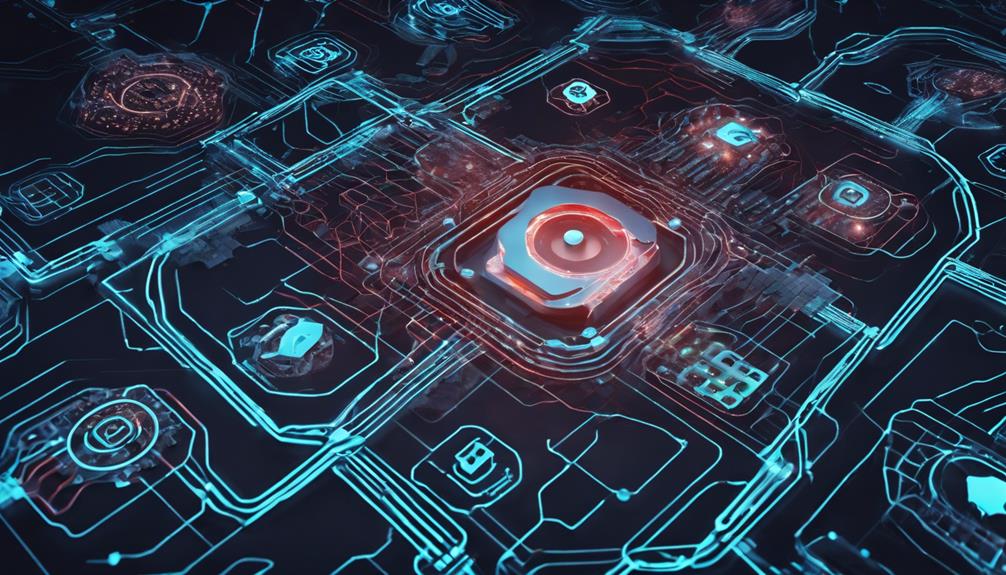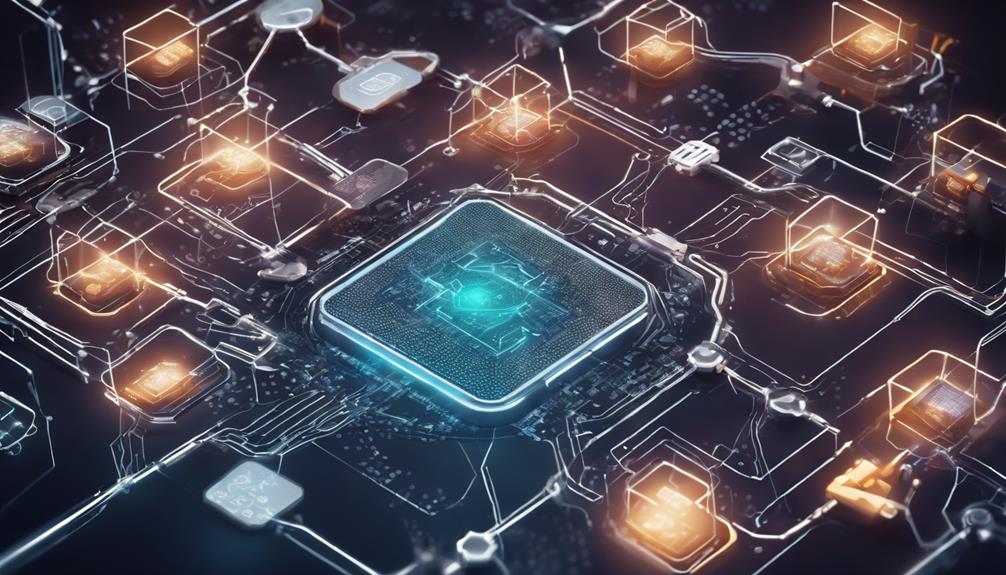Ransomware attacks continue to pose a significant threat to individuals and organizations. In 2021 alone, there was approximately one ransomware attack every 11 seconds, resulting in billions of dollars in damages1. These malicious attacks have the potential to cripple businesses, disrupt critical services, and compromise sensitive data. It is crucial to implement effective prevention and mitigation strategies to safeguard data and fend off cyber threats.
Understanding the nature of ransomware is the first step in protecting against these attacks. Ransomware is a sophisticated type of malware that encrypts data and holds it hostage until a ransom is paid2. It often targets individuals or businesses that are likely to pay the demanded sum to recover their data. Ransomware attacks can have devastating consequences, particularly for organizations that rely on sensitive information to operate effectively.
Various attack vectors are used by ransomware attackers to exploit vulnerabilities and gain unauthorized access. These include internet-facing vulnerabilities, compromised credentials, phishing, precursor malware infection, advanced social engineering, and targeting third parties and managed service providers1. Awareness and education are crucial to prevent these attacks. Regular employee training in cybersecurity awareness can help individuals identify and avoid potential threats.
One of the most important mitigation strategies against ransomware is to maintain offline, encrypted backups of critical data13. By keeping copies of important data on external hard drives or secure cloud servers, organizations can easily restore their files in the event of an attack. Regularly testing the availability and integrity of backups is critical to ensure their efficacy.
Another important measure is to keep all systems and software updated. Cybercriminals often exploit vulnerabilities in outdated systems to launch ransomware attacks. Regularly updating operating systems, web browsers, and antivirus software is essential to protect against these attacks12.
Installing comprehensive antivirus software and firewalls is also crucial for defending against ransomware. Antivirus software can scan for and detect cyber threats, while firewalls act as a first line of defense against external attacks1. Configuring firewalls correctly and being cautious of fake virus detection alerts are important practices to enhance cybersecurity.
Network segmentation can be an effective strategy in containing ransomware and preventing its spread across a network. By dividing the network into smaller subnetworks and implementing separate security controls, organizations can limit the impact of ransomware attacks1.
Email remains a common vector for ransomware attacks, and protecting against them requires caution. Vigilance when opening emails from unknown senders and avoiding clicking on suspicious attachments or links is crucial. Employing email authentication protocols such as SPF, DKIM, and DMARC can provide additional protection against phishing attempts and verify the authenticity of emails12.
Limiting user access privileges is another important security measure to prevent the spread of ransomware within organizations. Implementing the principle of least privilege ensures that users only have access to the data and resources necessary for their roles. Role-based access control policies can further enhance security by defining user permissions based on job responsibilities1.
In conclusion, ransomware attacks pose a significant risk to individuals and organizations, but implementing prevention and mitigation strategies can greatly reduce this risk. By maintaining offline backups, keeping systems updated, installing comprehensive security measures, practicing network segmentation, being cautious with emails, and limiting user access privileges, organizations can strengthen their defenses against ransomware attacks. Regular education and training in cybersecurity awareness are also vital to prevent these attacks13.
Key Takeaways:
- Implementing effective prevention and mitigation strategies is crucial to safeguard against ransomware attacks.
- Maintaining offline, encrypted backups of critical data is essential to restore files in the event of an attack.
- Regularly updating systems and software helps protect against vulnerabilities exploited by ransomware attackers.
- Installing comprehensive antivirus software and firewalls enhances cybersecurity defenses.
- Limiting user access privileges and practicing the principle of least privilege reduces the spread of ransomware within organizations.
What is Ransomware?
Ransomware is a sophisticated type of malware that encrypts data and holds it hostage until a ransom is paid. Cybercriminals often target individuals or businesses that are likely to pay the demanded sum to recover their data. Ransomware attacks can have devastating consequences, particularly for organizations that rely on personally identifiable information and sensitive data to operate.
It is crucial to be aware of common infection methods used by cybercriminals to distribute ransomware. These methods include:
- Phishing emails: Malicious emails disguised as legitimate correspondence, tricking users into opening attachments or clicking on links that execute the ransomware.
- Drive-by downloads: Infecting systems when users visit malicious websites or unknowingly download malware.
- System vulnerabilities: Exploiting security weaknesses in outdated software or operating systems to gain unauthorized access.
Ransomware attacks can disrupt business operations, compromise sensitive information, and result in significant financial losses. Organizations must implement robust security measures and educate users to prevent falling victim to these damaging cyber threats.
Implementing preventive measures and understanding the impact of ransomware attacks is crucial in today’s cyber landscape. According to statistical data2, ransomware has become increasingly impactful, with malicious actors actively targeting organizations of all sizes. The updated ransomware guide, based on insights from the Joint Ransomware Task Force and contributions from CISA, MS-ISAC, NSA, and FBI, offers valuable recommendations for protecting against ransomware.
Types of Ransomware
Ransomware attacks come in various forms, each with its own characteristics and modes of operation. Understanding the different types of ransomware can help individuals and organizations better protect themselves against these malicious threats.
Encryption Ransomware: One prevalent type of ransomware is encryption ransomware, which encrypts files on a device, making them inaccessible without a decryption key. This form of ransomware seeks to extort victims by demanding a ransom in exchange for the decryption key. It is estimated that there was approximately one ransomware attack every 11 seconds in 2021, resulting in almost $20 billion in damages4.
Lockers Ransomware: Another type of ransomware is lockers ransomware. This variant restricts access to a user’s computer, essentially locking them out of their system until the ransom is paid. Lockers ransomware takes control of the entire device, making it unusable until the victim complies with the attacker’s demands.
Scareware: Scareware is a form of ransomware that tries to deceive victims into paying a ransom by creating false security threats. This type of ransomware displays alarming messages on an infected device, tricking users into believing their system is compromised. Scareware attempts to pressure victims into purchasing unnecessary software or services to mitigate non-existent threats.
Doxware/Leakware: Doxware, also known as leakware, takes ransomware attacks to a new level by threatening to leak sensitive information unless the ransom is paid. In addition to encrypting files, doxware exfiltrates data from the victim’s device and holds it hostage. This double extortion tactic has become increasingly prevalent among malicious actors, who exploit the fear of data breaches to extort victims2.
These different types of ransomware highlight the evolving tactics employed by cybercriminals to exploit vulnerabilities and extort their victims. It is essential for individuals and organizations to stay informed about these threats and implement robust cybersecurity measures to defend against them.
Ransomware Statistics
| Statistic | Source |
|---|---|
| In 2021, there was one ransomware attack every 11 seconds, resulting in nearly $20 billion in damages | 4 |
| 54% of managed service providers (MSP) reported phishing as the top ransomware delivery method in 2020 | 4 |
| Phishing scams were listed as the top cybercrime in 2020 by the Federal Bureau of Investigation (FBI), causing over $4.2 billion in loss or theft | 4 |
Understanding the different types of ransomware and staying informed about the latest trends and statistics is crucial in developing effective prevention and mitigation strategies against these cybersecurity threats. By implementing robust security measures, organizations can minimize the risk of falling victim to ransomware attacks and protect their valuable data.
Backup Your Data
Regularly backing up your data is one of the most effective ways to mitigate the impact of a ransomware attack. By keeping copies of your important data on external hard drives or cloud servers, you can easily restore your files in the event of an attack.
The 3-2-1 backup rule is a recommended approach, which involves having three copies of your data on two different storage types, with one copy stored offline5. This strategy ensures that even if one backup fails or becomes compromised, you have alternative copies that are readily accessible. It is important to choose reliable external hard drives with sufficient storage capacity to accommodate your data.
Cloud servers are another secure option for data backup. Cloud storage provides the advantage of off-site storage, protecting your data from physical risks such as fire, theft, or natural disasters. Additionally, cloud servers often have built-in security measures and encryption protocols to guard against unauthorized access or data breaches.
When selecting a cloud server provider, consider factors such as storage capacity, data transfer speeds, and service reliability. Cloudian HyperStore is an example of a massive-capacity object storage device designed specifically for resilient backup activities, offering storage capacities of up to 1.5 Petabytes5. It is crucial to choose a cloud server provider that aligns with your data backup needs and ensures the safety and accessibility of your stored data.
In addition to choosing the right backup method, it is essential to regularly test your backups to ensure their efficacy6. Periodic backup testing helps identify any inconsistencies or errors in the backup process and allows for adjustments to be made to improve data recovery capabilities. Annual tests are common for companies, with additional tests conducted as needed when there are significant changes to hardware or software solutions.
By implementing a robust backup strategy, you can minimize the impact of a ransomware attack and ensure the availability of your critical data. Remember to adhere to the 3-2-1 backup rule, evaluate cloud server options, and regularly test your backups to maintain a strong defense against ransomware threats.
Keep All Systems and Software Updated
Ensuring that all systems, including operating systems, web browsers, and antivirus software, are kept up to date is essential in the fight against ransomware. Cybercriminals often target outdated systems because they are more vulnerable to security breaches and attacks. For instance, the infamous WannaCry ransomware attack in 2017 specifically targeted computers with outdated versions of Microsoft Windows, exploiting known vulnerabilities7. By promptly applying patches and updates, individuals and organizations can effectively protect their systems from these types of attacks.
Regular software updates play a vital role in closing security gaps that can be exploited by threat actors. Cyber threats and attack techniques are constantly evolving, and software developers release updates to address these emerging risks. By keeping software up to date with the latest security patches, individuals and organizations can ensure that their systems are equipped with enhanced defenses against ransomware and other cyber threats78.
Outdated legacy systems present an increased risk of falling victim to ransomware attacks. These systems, whether in use by individuals or businesses, often lack the necessary security measures and may have known vulnerabilities. By regularly updating and upgrading these systems, users can minimize their exposure to ransomware and strengthen their cybersecurity defenses78.
In addition to operating system and software updates, it is crucial to keep antivirus software up to date. Antivirus programs play a critical role in detecting and blocking ransomware and other malware. Regular updates ensure that the antivirus software has the latest virus definitions and threat intelligence to effectively identify and neutralize potential threats7.
Benefits of System Updates and Software Patches:
1. Enhanced Security: System updates and software patches often include bug fixes and security enhancements that address known vulnerabilities and protect against emerging threats78.
2. Protection Against Exploits: Outdated systems are more susceptible to exploit kits and methods used by cybercriminals. By keeping systems up to date, individuals and organizations can minimize the risk of attacks and potential damage caused by ransomware78.
3. Improved Performance: System updates and software patches often include performance optimizations that enhance the overall user experience and efficiency of the system7.
4. Compatibility: System updates and software patches ensure compatibility with the latest applications and technologies, reducing the risk of compatibility issues that could lead to system vulnerabilities7.
5. Confidence and Peace of Mind: By regularly updating systems and applying software patches, individuals and organizations can have greater confidence in their cybersecurity posture and enjoy peace of mind, knowing that they have taken proactive measures to protect against ransomware attacks7.
Install Antivirus Software & Firewalls
Comprehensive antivirus software and firewalls are essential components in safeguarding against ransomware attacks and protecting sensitive data from cyber threats. Antivirus software plays a crucial role in scanning and detecting potential malware and malicious activities, ensuring early detection and prevention of ransomware infiltrations. Additionally, firewalls act as the first line of defense by monitoring and filtering incoming and outgoing network traffic, blocking unauthorized access attempts, and controlling data flow.
When selecting antivirus software, it’s vital to choose a reputable and reliable solution that offers robust real-time protection against various types of malware, including ransomware. A reliable antivirus program should include features such as antivirus scanning, anti-malware protection, and web browser security, among others, to provide comprehensive defense against cyber threats.
Furthermore, firewalls offer an additional layer of protection by actively monitoring network traffic and enforcing security policies. Firewalls can be configured to block unauthorized access attempts and restrict traffic to known malicious IP addresses, reducing the risk of ransomware attacks. Additionally, firewalls can impose restrictions on specific ports commonly targeted by ransomware, such as port 445, limiting the potential entry points for attackers.
Implementing both antivirus software and firewalls in tandem strengthens the overall cybersecurity posture and significantly reduces the risk of ransomware infections and data breaches.4
Configuring Firewalls Correctly
To ensure the effectiveness of firewalls, it is essential to properly configure them based on specific security requirements. Incorrect firewall configurations can leave vulnerabilities that can be exploited by cybercriminals.
Configuration best practices for firewalls include:
- Reviewing and updating default firewall settings to align with security policies and guidelines.
- Implementing rule-based and application-level firewalls to provide granular control over network traffic and filter out potential threats.
- Regularly updating firewall firmware and software to address known vulnerabilities and ensure the latest security patches.
- Enabling logging and monitoring features to detect suspicious activities and potential security breaches.
- Conducting regular firewall audits and penetration testing to identify and address any security gaps.
By following these firewall configuration best practices, organizations can maximize their ransomware defense capabilities and protect their valuable data from unauthorized access and potential ransomware attacks.9

Network Segmentation
Network segmentation is a vital strategy for effectively containing ransomware attacks and minimizing their impact on an organization’s infrastructure4. By dividing the network into smaller subnetworks or segments, distinct security controls can be implemented to isolate potential threats and prevent their spread across the entire network.
When implementing network segmentation, organizations can establish different levels of access privileges and security controls based on the sensitivity and criticality of the data within each segment. This approach ensures that even if one segment is compromised by ransomware, the other segments remain protected, limiting the potential damage and enabling security teams to respond and mitigate the threat effectively.
With network segmentation, security teams gain valuable time to identify, analyze, and remove the ransomware infection from the affected segment. This reduces the overall impact of the attack and allows for a more targeted and efficient response4. Simultaneously, segmentation enables organizations to monitor and defend against ransomware more effectively by focusing their security resources on specific segments rather than the entire network.
Benefits of Network Segmentation:
- Ransomware Containment: Network segmentation helps to isolate and limit the impact of ransomware attacks, preventing them from spreading across the entire network.
- Data Isolation: By segmenting the network, organizations can separate sensitive data from other less critical systems, enhancing data protection and reducing the risk of data loss or theft in the event of a ransomware attack.
- Enhanced Security Controls: Each network segment can have its own security controls and access policies tailored to the specific requirements and sensitivity of the data it contains. This allows organizations to enforce stricter security measures for critical segments, minimizing the risk of ransomware infections.
By implementing network segmentation as part of a comprehensive cybersecurity strategy, organizations can significantly enhance their ability to defend against ransomware attacks and protect critical data. It is an essential layer of security that complements other preventive measures such as regular backups, system updates, and user awareness training.

| Network Segmentation Best Practices |
|---|
| 1. Identify Critical Assets: Determine which systems and data require the highest level of protection and create dedicated segments for them. |
| 2. Develop Access Policies: Define access controls and permissions for each segment based on user roles and responsibilities. |
| 3. Segmentation Technology: Utilize firewall rules, VLANs (Virtual LANs), or software-defined networking (SDN) solutions to create and manage network segments. |
| 4. Regular Monitoring: Continuously monitor network traffic and segment interactions to detect any suspicious activities or unauthorized access attempts. |
| 5. Segmentation Testing: Regularly test the effectiveness of network segmentation by simulating real-world scenarios and response exercises. |
Implementing network segmentation is a proactive measure that enhances an organization’s overall cybersecurity posture, making it more resilient against ransomware threats. By combining network segmentation with other preventive and detective controls, organizations can effectively protect their data, systems, and operations from the devastating consequences of ransomware attacks.
Email Protection
Email phishing, suspicious attachments, malicious links, and social engineering tactics continue to be common methods used by cybercriminals to launch ransomware attacks. It is crucial for individuals and organizations to be vigilant and take proactive measures to protect themselves from these threats.
Exercise Caution with Emails
When it comes to email protection, one of the most important steps is to exercise caution when opening emails, especially those from unknown senders. Phishing emails often mimic legitimate communications and attempt to trick recipients into revealing sensitive information or clicking on malicious links. By being wary of suspicious emails and avoiding interactions with their contents, users can reduce the risk of falling victim to a ransomware attack.4
Avoid Opening Suspicious Attachments and Links
Ransomware can be easily delivered through malicious attachments or links in emails. Therefore, it is vital to refrain from opening any attachments or clicking on links that appear suspicious or unexpected. These attachments and links might initiate the download of malware onto the recipient’s device, leading to a potential ransomware infection. Staying cautious and skeptical can go a long way in preventing such attacks.4
Implement Email Authentication Protocols
Email authentication protocols, such as SPF (Sender Policy Framework), DKIM (DomainKeys Identified Mail), and DMARC (Domain-based Message Authentication, Reporting, and Conformance), can provide an additional layer of protection against email-based threats. SPF verifies that emails originate from authorized servers, DKIM adds digital signatures to emails to verify their authenticity, and DMARC aligns SPF and DKIM results to determine the fate of suspicious emails. Implementing these protocols can help prevent email spoofing and enhance email security.4
“Implementing proper email protection measures, such as exercising caution when dealing with emails, avoiding suspicious attachments and links, and using email authentication protocols, can help individuals and organizations shield themselves from the ever-present threat of ransomware.”4
| Statistical Data | |
|---|---|
| 1. | One ransomware attack every 11 seconds occurred in 2021 |
| 2. | Around $20 billion in damages resulted from ransomware attacks in 2021 |
| 3. | Phishing was reported as the top ransomware delivery method by 54% of managed service providers in 2020 |
| 4. | Phishing scams accounted for over $4.2 billion in loss or theft in 2020 |
Implementing robust email protection strategies is crucial in safeguarding against ransomware attacks. By exercising caution, avoiding suspicious attachments and links, and implementing email authentication protocols, individuals and organizations can significantly reduce their risk of falling victim to these threats. Staying informed and proactive is key to maintaining strong defenses against evolving cyber threats.

Application Whitelisting
Application whitelisting serves as a crucial cybersecurity measure to protect networks from unauthorized programs and websites. By creating a comprehensive list of approved applications and blocking unauthorized ones, organizations can significantly reduce the risk of ransomware infections and enhance their security posture.
Unauthorized programs pose a significant threat to network security, as they often act as gateways for malicious activities. Implementing secure configurations and regularly updating the whitelist not only ensures that only trusted applications are allowed but also mitigates the risk of unauthorized software compromising network integrity and data confidentiality.
According to statistical data4, phishing emails remain one of the primary delivery methods for ransomware attacks, accounting for 54% of infections reported by Managed Service Providers. Application whitelisting serves as a powerful defense mechanism against phishing scams as it prevents the execution of malicious software downloaded through deceptive emails.
Additionally, the WannaCry ransomware attack in 2017, which targeted outdated versions of Microsoft Windows, highlights the importance of maintaining secure configurations. By whitelisting only authorized applications, organizations can prevent ransomware variants from exploiting vulnerabilities in legacy software and compromising system integrity, as stated in statistical data4.
Organizations that prioritize application whitelisting can also benefit from better network segmentation. According to statistical data4, network segmentation is a crucial strategy for limiting the spread of ransomware. By isolating infected systems, security teams have more time to detect, isolate, and remove threats, minimizing the potential impact of ransomware attacks on critical data and resources.
In conclusion, application whitelisting plays a pivotal role in ensuring robust cybersecurity. With its ability to prevent the execution of unauthorized programs and websites, organizations can strengthen their defenses against ransomware attacks, as supported by statistical data4. Regular updates and secure configurations are essential to maintaining the effectiveness of application whitelisting and protecting networks from evolving cyber threats.
Endpoint Security
With the increasing prevalence of remote work, endpoint security has become crucial for organizations to protect their data and systems from ransomware attacks. Implementing robust endpoint protection platforms (EPP) and endpoint detection and response (EDR) solutions is essential in mitigating the risk of cyber threats targeting remote devices.
Endpoint Protection Platforms (EPP) and Endpoint Detection and Response (EDR) encompass a suite of security tools, including antivirus and anti-malware software, data encryption, intrusion detection, and real-time security alerts. These technologies provide organizations with a comprehensive defense against ransomware attacks, detecting and blocking malicious activities on remote devices.
Reference:4
One of the key benefits of endpoint security solutions is their ability to proactively monitor and manage the security of remote devices. As employees connect to corporate networks from various locations, it is crucial to have continuous visibility into the security status of these endpoints. EPP and EDR solutions enable organizations to monitor remote devices for any signs of compromise or suspicious activity, allowing for prompt detection and response to potential ransomware threats.
Implementing proper endpoint security measures plays a vital role in preventing ransomware attacks through compromised devices. Cybercriminals often exploit vulnerabilities in remote devices to gain unauthorized access and distribute ransomware. By securing endpoints with EPP and EDR solutions, organizations can significantly reduce the risk of falling victim to these attacks.
Reference:10
When it comes to mobile security, endpoint protection becomes even more critical. As employees access corporate data and applications from their mobile devices, it is essential to secure these endpoints against ransomware threats. EPP and EDR solutions offer mobile security features that protect against malicious apps, phishing attempts, and other mobile-based attack vectors.
Reference:4
In addition to implementing EPP and EDR solutions, organizations should establish security policies for mobile devices used for work purposes. These policies may include enforcing the use of strong passwords or biometric authentication, enabling remote device wiping in case of loss or theft, and regularly updating mobile operating systems and applications to address potential vulnerabilities.
Endpoint security serves as a critical layer of defense against ransomware attacks, especially in the context of remote work and the increasing use of mobile devices for business purposes. By adopting EPP and EDR solutions, organizations can enhance their cybersecurity posture, protect sensitive data, and minimize the risk of costly ransomware incidents.
Reference:10
Limit User Access Privileges
One of the most effective security measures against ransomware attacks is to limit user access privileges. By adopting the principle of least privilege, organizations ensure that users only have access to the data and resources necessary for their roles, minimizing the potential impact of a ransomware attack4. Role-based access control policies further enhance security by defining user permissions based on job responsibilities, preventing unauthorized access to critical systems and sensitive data4.
Restricting user access privileges is crucial because ransomware attacks often exploit vulnerabilities linked to excessive system access and user permissions. Cybercriminals infiltrate networks and gain control over sensitive data by exploiting the overprivileged user accounts, such as local administrators, with broad access privileges3. By limiting access privileges to the exact requirements of each user’s role, organizations reduce the attack surface and minimize the likelihood of ransomware spreading through the network.
Ransomware attackers primarily target individuals or businesses likely to pay the demanded ransom to retrieve their data. By implementing role-based access control and granting users only the necessary access privileges, organizations mitigate the risk of becoming attractive targets for ransomware attacks4. Adhering to the least privilege principle not only safeguards against ransomware but also enhances overall cybersecurity posture.
The Principle of Least Privilege
The principle of least privilege dictates that users should be granted the minimum permissions required to perform their job functions without compromising productivity or security. By adhering to this principle, organizations significantly diminish the potential impact of a ransomware attack4.
Limiting user access privileges means granting access to specific resources, systems, and data based on an individual’s job responsibilities and requirements. Users should not have access to unnecessary files or administrative controls that could be exploited by ransomware. By strictly applying the least privilege principle, organizations minimize the risk of unauthorized data access and manipulation by a ransomware attacker3.
Role-Based Access Control
Role-based access control (RBAC) provides a robust framework for managing user access privileges and permissions. With RBAC, access to systems and data is determined by an individual’s role within the organization, ensuring that users only have the necessary access rights to perform their job functions43).
RBAC involves defining user roles, such as administrators, managers, or regular employees, and assigning specific permissions to each role. This approach reduces the risk of unauthorized access to critical systems and sensitive data, limiting the potential for a ransomware attack to propagate across a network4. By implementing RBAC, organizations can minimize the potential fallout of a ransomware attack by controlling user privileges and containing the spread of malware.
Role-based access control offers several advantages in defending against ransomware attacks. It ensures that employees only have access to the resources needed to fulfill their job responsibilities, reducing the likelihood of accidental or intentional data exposure. Additionally, RBAC simplifies access management, providing a systematic approach to reviewing and revoking access rights as job roles change.
| Benefits of Limiting User Access Privileges: |
|---|
| • Minimizes the risk of data breaches and ransomware propagation43) |
| • Reduces the attack surface by limiting access to critical systems and sensitive data4 |
| • Prevents unauthorized manipulation or leakage of valuable information3 |
| • Facilitates efficient access management and administration43) |
Limiting user access privileges and employing role-based access control are essential components of a comprehensive defense strategy against ransomware attacks. By adhering to the principle of least privilege and implementing RBAC, organizations can significantly reduce the likelihood and impact of ransomware incidents, safeguarding critical systems and protecting sensitive data43).
Review Port Settings
Ransomware attackers are known to exploit vulnerabilities in specific port settings, such as the RDP port 3389 and the SMB port 445. It is crucial for organizations to thoroughly review these port settings and evaluate the necessity of keeping them open. By limiting connections to trusted hosts only, organizations can significantly reduce their attack surfaces and minimize the risk of unauthorized access by cybercriminals.
CIS Control 4 emphasizes the importance of reviewing and controlling port settings to enhance network security and prevent ransomware attacks. By implementing this control, organizations can safeguard their systems against potential threats and unauthorized connections.
Restricting access to RDP and SMB ports greatly reduces the opportunity for malicious actors to exploit these entry points. By carefully reviewing these port settings and ensuring that connections are limited to trusted hosts, organizations can strengthen their network security measures and mitigate the risk of ransomware infiltrations.
In addition to reviewing port settings, it is crucial for organizations to regularly update their systems to apply the latest security patches (CIS Control 7). This ensures that any known vulnerabilities associated with these ports or other components of the IT infrastructure are addressed promptly. By keeping systems up to date, organizations can effectively fortify their defenses against ransomware attacks and other cyber threats.
By proactively reviewing and controlling port settings, organizations demonstrate a commitment to network security and preventing unauthorized access. This mitigation strategy aligns with best practices recommended by industry frameworks such as the Center for Internet Security (CIS) and helps establish a robust defense against ransomware attacks.

| Security Control | Description |
|---|---|
| CIS Control 4 | Review and control port settings, including RDP port 3389 and SMB port 445. |
| CIS Control 7 | Regularly update systems to apply the latest security patches. |
Cybercriminals often target organizations through RDP and SMB ports, exploiting vulnerabilities to infiltrate their networks. However, by following best practices outlined in CIS Control 4 and 7, such as reviewing and limiting port settings and keeping systems updated, organizations can effectively safeguard their network security and reduce the risk of falling victim to ransomware attacks. Implementing these measures is crucial for maintaining robust cyber defenses and protecting valuable data.
References:
- Ransomware attacks are prevalent across various sectors, including local government entities and large organizations. (Source: Link 111)
- Reviewing port settings, specifically RDP port 3389 and SMB port 445, can help organizations limit attack surfaces and connections to trusted hosts according to CIS Control 4. (Source: Link 111)
- Organizations are recommended to update systems regularly to apply the latest security patches, as per CIS Control 7. (Source: Link 111)
Conclusion
As the threat of ransomware attacks continues to grow, organizations must prioritize prevention and mitigation strategies to safeguard their data and defend against cyber threats. With statistics showing that 85% of organizations are likely to experience a ransomware attack this year1, and a new target being hit by ransomware every 14 seconds1, it is clear that proactive measures are necessary.
Implementing a multi-layered defense approach is crucial in mitigating the risks of ransomware attacks. This includes maintaining offline, encrypted backups of critical data1 and regularly updating “golden images” of critical systems1. A zero trust architecture can help prevent unauthorized access to data and services1. Training employees in cybersecurity awareness is vital to promote a security-conscious culture within the organization1.
Furthermore, strong access controls and privilege management should be put in place to limit the potential impact of ransomware attacks1. Developing an incident response plan and conducting regular drills are crucial for effective ransomware mitigation1. Timely software patching with security updates helps address vulnerabilities that ransomware might exploit7.
In terms of solutions, the best ransomware mitigation strategy should include real-time intrusion detection systems, an incident management dashboard, effective backup solutions, and a zero-trust architecture1. CTERA offers a Global File System with ransomware mitigation and protection features, including Ransom Protect, an AI-driven ransomware defense mechanism1.
By following these prevention and mitigation strategies, organizations can significantly reduce the risk of falling victim to ransomware attacks and protect their valuable data and resources from cybercriminals.
FAQ
What is ransomware?
What are the types of ransomware?
How can I protect my data from ransomware?
Why is it important to keep systems and software updated?
How can antivirus software and firewalls help in ransomware defense?
What is network segmentation?
How can I protect against ransomware attacks through email?
What is application whitelisting?
How can I secure remote devices?
What is the principle of least privilege?
Why should I review and control port settings?
How can I prevent ransomware attacks?
Why is it important to stay vigilant in ransomware prevention and mitigation efforts?
Source Links
- https://www.ctera.com/company/blog/ransomware-mitigation-best-practices/
- https://www.cisa.gov/stopransomware/ransomware-guide
- https://delinea.com/blog/ransomware-mitigation
- https://www.upguard.com/blog/best-practices-to-prevent-ransomware-attacks
- https://cloudian.com/guides/ransomware-backup/ransomware-backup/
- https://www.mimecast.com/content/ransomware-backup/
- https://www.linkedin.com/pulse/ransomware-attacks-mitigation-strategies-cloudmatos-leecc
- https://perception-point.io/guides/ransomware/how-to-prevent-ransomware-15-ways-to-prevent-the-next-attack/
- https://www.algosec.com/resources/ransomware/
- https://www.sophos.com/en-us/cybersecurity-explained/ransomware-mitigation
- https://www.cisecurity.org/insights/blog/7-steps-to-help-prevent-limit-the-impact-of-ransomware









